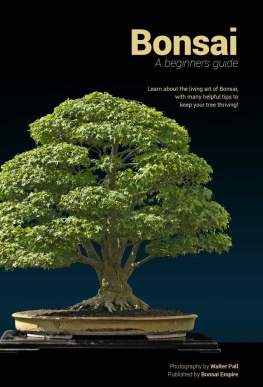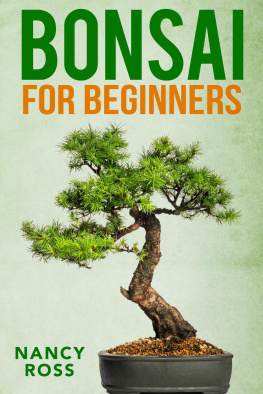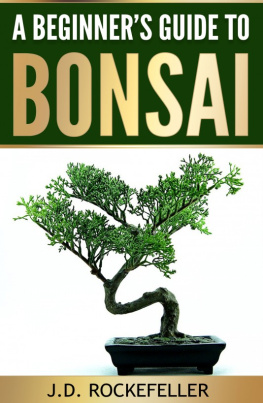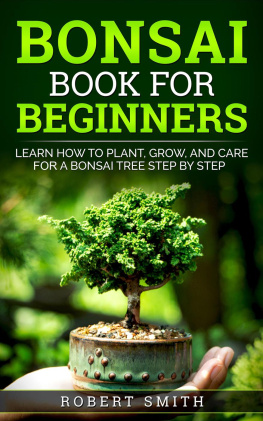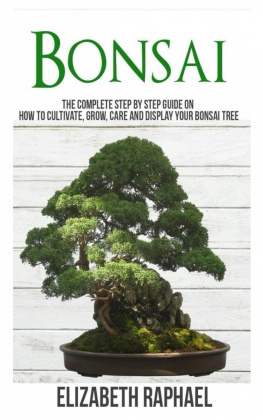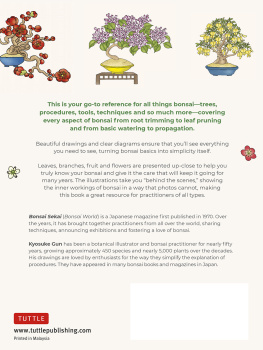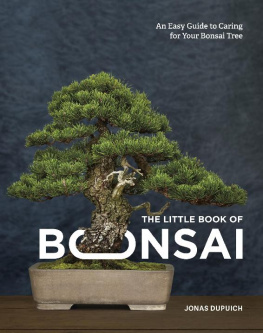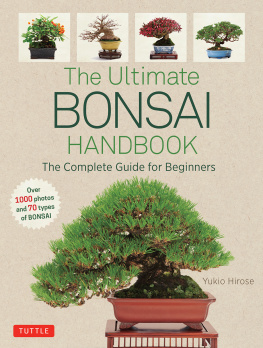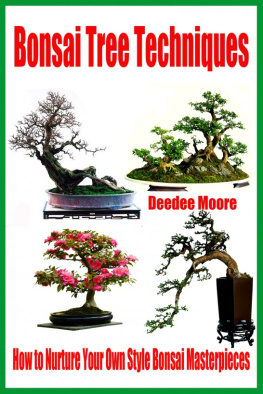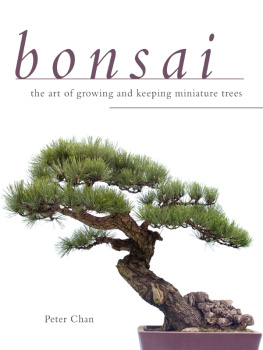Bonsai
A beginners guide
Photography by Walter Pall and Mauro Stemberger
Published by Bonsai Empire
Copyright 2014 Bonsai Empire
Contents
Bonsai: A beginners guide
Introduction
Bonsai trees are small, potted trees that are well-known parts of the Japanese culture. The living art of Bonsai represents peace and tranquility, as well as long-lasting determination and patience. A bon is a flat tray or shallow pot, and sai means plant or planting. Originally from China, Bonsai trees date back hundreds of years and are well known for their miniature appearance.
Bonsai trees can come in an array of types and can be grown in a variety of ways. They require daily grooming, but arent high maintenance. Unlike what most people believe, keeping a Bonsai tree alive and thriving isnt difficult. They do require simple attention and need to be tended to at least once a day.
In this book, youll learn more about the art of Bonsai and the history behind it, as well as tips for caring for your own Bonsai tree.
Chapter 1

Design principles and inspiration
The ultimate goal of growing a Bonsai is to create a miniaturized but realistic representation of nature in the form of a tree. Bonsai are not genetically dwarfed plants, in fact, any tree species can be used to grow one. The best Bonsai whether a single tree or a multi-plant or rock landscape composition touch us, make us take notice, stop us as they catch our experience and imaginations to show us something new.

Thick trunks, textured bark, an interplay of twisting live wood and deadwood, surface roots, fine branch and twig ramification, foliage pads, relatively small leaves or needles, a complementary and relatively shallow container, tiny fruit or cones or flowers these are just a few of the more obvious features that can be used to help portray a miniature landscape. They are not all needed or possible in any one given composition, and they cannot simply be included just because. A true master artisan knows, feels what is needed. And his or her creation touches us, also. Those true masterpieces are the ones which, when you first look at them, can momentarily take your breath away and raise a smile.
Linden (Tilia Platiphyllos) in nature
Bonsai-in-training (also known as potensai, potential Bonsai) should point to a future, more mature creation, in which the artist has somewhat in mind. And because these are made with living, growing things, those future pieces are never complete or finished. They will be presented within certain biological parameters, subject to health issues or remodeling by the tree with the caretakers assistance. The oldest and longest-containerized Bonsai because of natural changes can undergo several different styles throughout their long lives. These trees can, in fact, live longer than their full-size counterparts because of our increased attention to their health, water and nutritional needs, protection from weather extremes, injuries needing care, or pest infestations requiring containment or removal.
Techniques such as pinching buds, pruning and wiring branches, and carefully restricting but not abandoning fertilizers are used to limit and redirect healthy growth. Most commonly kept under four feet (or about a meter) in height, Bonsai are not genetically dwarfed plants. However, plants with smaller leaves do make these compositions easier to design. In fact, any plant species that has a woody stem or trunk, grows true branches, can be successfully grown in a container to restrict its roots/food storage capability, and has smaller or reducible-leaves can be used to create a Bonsai.
Look around at your trees, bushes, hedges, the copses in your yard or park, plants in the nursery or wild landscape essentially any of those can be starter material. Carefully collected during the appropriate growing or dormant season with proper permission, your composition is begun. Most native plants can then be grown outdoors; material from more tropical climates needs at least some protection from the elements in the temperate zones.
Bonsai size classifications
The ultimate goal of Bonsai is to create a realistic depiction of nature. As a Bonsai gets smaller (even down to a few inches/centimeters) it increasingly becomes abstract, as opposed to resembling nature in a more precise way. Several classifications of Bonsai have been put forward, and although the exact size classifications are disputed, they help to gain understanding of the aesthetic and botanical aspects of Bonsai. The classifications are originally based on the number of men needed to lift the actual tree.
The size classifications, increasing in size |
Keshitsubo | 1-3 | (3-8 cm) |
Shito | 2-4 | (5-10 cm) |
Mame | 2-6 | (5-15 cm) |
Shohin | 5-8 | (13-20 cm) |
Komono | 6-10 | (15-25 cm) |
Katade-mochi | 10-18 | (25-46 cm) |
Chumono / Chiu | 16-36 | (41-91 cm) |
Omono / Dai | 30-48 | (76-122 cm) |
Hachi-uye | 40-60 | (102-152 cm) |
Imperial | 60-80 | (152-203 cm) |
Bonsai sizes illustrated
Related arts
While Bonsai specifically refers to dwarf potted trees based on the Japanese model, it is also used as a generic term for related artforms in other countries, which include but are not limited to the following:
Penjing are the older and original form of Chinese miniature landscapes. They usually include rocks to represent mountains, hills, and cliffs. Sometimes they are even all the way up to 10 (or 3 meter) tall.
Saikei are the newer and smaller Japanese versions of penjing. These are made with rocks, small plants/groundcovers, and underdeveloped trees (which could someday become independently potted Bonsai).
Hn non b are Vietnamese miniature landscapes from 1 to 25 (0.3 to 7.6 m) high, made with rocks, plants and water imitating island scenery, mountains and surroundings.
Mai-dt are the Thai compositions which are more angular and symbolic, somewhat likened to stylized dancers poses.
Japanese White Pine (Pinus Pentaphylla) by Walter Pall.
Estimated age: 50 years. Height: 110 / 55 cm

